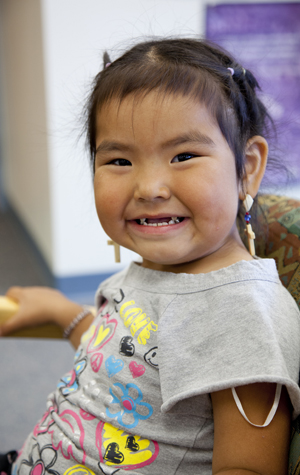Extreme Dentistry in a Faraway Place
BU dental student takes his skills to Alaska
Locals call it the bush, a term used to describe anyplace you can’t get to by road. And you can’t get to the tiny town of Bethel, in Alaska’s Yukon-Kuskokwim Delta, by road. You have to fly in from Anchorage. That’s how Andrew Jorgensen got there last summer, on a 12-person puddle jumper. The Goldman School of Dental Medicine student spent a three-week externship fixing the teeth of people whose dental decay rate hovers between 7 and 10 times the national average.
The inaccessibility of the YK Delta leaves it with few jobs, little money, and sky-high prices for healthful food. Milk costs $8 a gallon. Soda on the other hand can be cheaper than bottled water and has become the beverage of choice for adults and children. That’s one reason that each year, about 400 infants and toddlers are sent to the operating room at the Yukon-Kuskokwim Health Corporation (YKHC) in Bethel, where they are strapped to papoose boards and anesthetized so dentists can extract their rotted front teeth.

In Bethel’s clinic, which is YKHC headquarters, Jorgensen studies the X-ray of a young woman’s teeth, and he spots cavities between every tooth.
“See that?” he says to his patient. “Once the decay gets halfway through the enamel, we have to fill them. Fluoride and flossing won’t fix that anymore.” The woman looks at the floor, her side-swept bangs hiding her blushing cheeks. Jorgensen (SDM’13) arranged his externship through the Indian Health Service (IHS) and YKHC, which serves the people of Bethel, Toksook Bay, and approximately 50 other villages of the YK Delta, an area in the southwestern corner of Alaska the size of Oregon. Summers up there are temperate, with temperatures rising to the 70s, but the winters are unforgiving. Every car and truck has an electric cord poking through its grille, the telltale sign of a block heater used to keep engines warm enough to turn over in temperatures as low as -50F.

There are 12 dentists in the health center here, and they do their best to serve the region’s 25,000 people, putting the dentist-to-patient ratio at about half of what it is nationally. Worse, several YKHC dentists are scheduled to leave in the near future when their contracts end. To fill the area’s dental care void, the YKHC has set up five subregional clinics, each of which will be staffed by two dental health aide therapists (DHATs), whose two years of training equips them to do uncomplicated extractions and fillings. The DHATs, who also educate patients about the importance of preventive dental care, are native Alaskans, and they are fluent in Yup’ik, the language spoken by most patients.
Jorgensen, on the other hand, speaks no Yup’ik, although he does have some Native American heritage: his great aunt, a Chippewa from Sault Ste. Marie, Mich., once had back surgery performed by IHS doctors. Jorgensen’s father is a dentist, and although he sold his practice years ago, he still sees patients a couple of days a week. Jorgensen is 29, and dentistry is his second career choice. He first earned a degree in engineering and worked for several years as an aerospace engineer.

“Dentistry is a mix of art and technical science,” he says, explaining his career change. “It’s a helping profession, and you get to work with your hands. So I think it’s a great fit for me.”
During his three weeks in the YK Delta, Jorgensen treated as many as 10 patients a day, working both in Bethel (population 6,000) and in Toksook Bay (population 600). He filled cavities, did root canals, and performed far more extractions than he had expected. “Many of the people have teeth that just aren’t savable,” he says. “Really all you can do is an extraction. It gets them out of pain.”

His externship mentor was YKHC staff dentist Mark Scott, who says that before commercial foods became widely available, the people of the YK Delta had excellent dental health, with full arches and no decay. “The natives grew up on a diet from hunting, fishing, berry picking, and very little if no sugar,” says Scott. Today the shelves of village stores are stocked with sugary snacks and sodas, and tooth decay is rampant.
“He’s been a great mentor,” says Jorgensen. “He’s the guy I’ve been working side-by-side with, patient by patient. He’s helping with treatment planning—‘What would you do if you had this situation…’—and each case brings up more questions and answers.”
Jorgensen says he learned different, and valuable, things from all of the dentists he worked with in Alaska, including some “tricks of the trade that you don’t learn in dental school.”
“They’re willing to let you work through problems at your own pace,” he says. “They don’t hold your hand. They let you problem-solve on a treatment planning scale that you don’t see in dental school. I’ve had the opportunity to work with patients who didn’t speak my language, and that’s been a challenge. It really opened my eyes. In Boston, you don’t see kids who come in with cavities in every one of their teeth.”
An earlier version of this story stated incorrectly that 12-person planes were the only way to fly to Bethel. There are, in fact, also seats on large cargo planes. The earlier version also attributed the popularity of soda solely to its low price. YK Delta health experts say instead that the locals have an extreme fondness for sugary beverages.
Comments & Discussion
Boston University moderates comments to facilitate an informed, substantive, civil conversation. Abusive, profane, self-promotional, misleading, incoherent or off-topic comments will be rejected. Moderators are staffed during regular business hours (EST) and can only accept comments written in English. Statistics or facts must include a citation or a link to the citation.